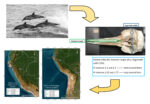Distribution of short and long-beaked common dolphin morphs (Delphinus spp.) based on skull’s rostrum index analysis along the Peruvian and Chilean coast
Luis Santillán, Aldo S. Pacheco, Jean-Noël Martinez, Jorge Fupuy, Roger Barboza, Susana Cárdenas-Alayza, Daniel A. Torres, Evaristo López, César Medina, Víctor Pacheco, Jhoann Canto-Hernández, Joanna Alfaro-Shigueto, Paquita RamírezThe distribution of the long-beaked and short-beaked common dolphin morphs in the eastern South Pacific is not well defined. The objective of this study was to propose a potential distribution of the two forms along the coast of Peru and part of Chile based on the rostral index obtained from the ratio of rostral length and zygomatic width. This phenotypic criterion was implemented in skulls deposited in museum collections in Peru and Chile. Based on classification, we were able to determine the distribution of each morphotype considering the collection location. A total of 44 skulls were analyzed, three of which did not have collection location. The results show that both forms of the common dolphins were distributed along the coast of Peru, but only the short-beaked common dolphin occurred in Chile. A larger number of short-beaked specimens were detected, especially in northern Peru. It was remarkable that the long-beaked was less common than expected since it is usually sighted in neritic waters. Around the 13° S latitude degrees there seems to be an overlapping area with specimens of the two forms. Our study provides an analysis of the distribution of the two forms of common dolphins by implementing a discrimination index developed for North Pacific populations. Some patterns of segregation were observed, but this should be contrasted with a larger number of skulls and the application of other phenotypic criteria specific to the South Pacific.
Distribución de delfín común (Delphinus spp.) de hocico corto y hocico largo en base al índice rostral a lo largo de la costa de Perú y Chile. La distribución de los morfotipos de delfín común de hocico largo y de hocico corto en el Pacífico suroriental no está claramente definida. El objetivo de este estudio fue proponer una distribución potencial de ambas formas de delfines comunes a lo largo de la costa de Perú y parte de Chile en base al índice rostral obtenido a partir de la relación del ancho cigomático y la longitud rostral. En esta investigación se implementa este criterio fenotípico en cráneos depositados en colecciones de museos del Perú y Chile. A partir de la clasificación, pudimos determinar la distribución de cada morfotipo considerando la localidad de colecta. El total de cráneos analizados fue de 44, tres de los cuales no contaron con localidad de colecta disponible. Los resultados indican que las dos formas de delfines comunes se distribuyeron a lo largo de la costa de Perú, pero en Chile solo estuvo presente el de hocico corto. Se detectó un mayor número de ejemplares de hocico corto, particularmente en las zonas del norte del Perú. Es notable que la variedad de hocico largo sea menos frecuente de lo esperado, ya que es usualmente reportado en aguas neríticas. Alrededor de los 13° de latitud sur sería un área donde se superponen ambas formas. Nuestro estudio proporciona un análisis de la distribución de las dos formas de delfines comunes mediante la implementación de un índice de discriminación desarrollado para poblaciones del Pacífico Norte y muestra algunos patrones de segregación que deben ser contrastados con una mayor cantidad de cráneos e implementado otros criterios fenotípicos más específicos para el Pacífico Sur.
